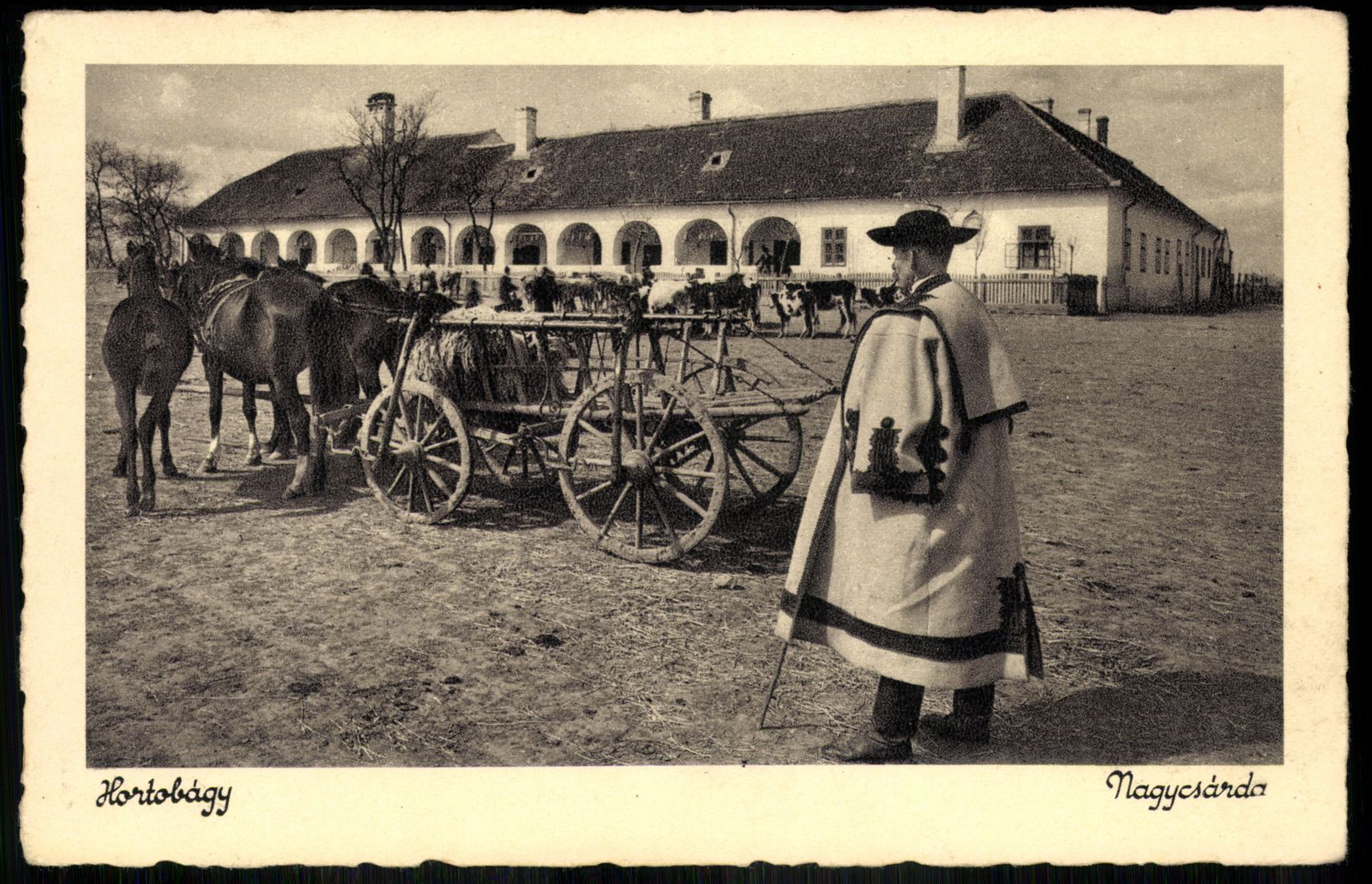Puszta inns
The first written mentioning of our term csárda (inn) is dated back to 1755. Its predecessor fogadó or vendégfogadó (public house, auberge) appears in documents from the 13th century. According to Zoltai the past of the inns, at least on the Great Plain, more exactly in the regions of the Hortobágy and Debrecen, cannot reach farther back than the expulsion of the Turks, or rather the decades following the peace-treaty of Szatmár (1711), when more peaceful times came. "It would be a great mistake to associate the origins of roadside inns with Turkish influence, with the imitation of oriental serais."
The inns built on remote plains or next to villages were important factors of internal traffic before railways. In the puszta, inns were built half a days walk from each other.
The old inns were simple, modest buildings. The puszta inns comprised two buildings facing each other. On one side of the road, the whole building contained the public house with a taproom with railed-off counter, wine-cellar and room-and-kitchen apartment of the tapster. In some of the inns a few guest-rooms were also built. The inns with many guest-rooms, such as the inns of Great-Hortobágy and Kadarcs, were rare. The columnar-porch, where the poorer travelers spent the night, was an indispensable part of the inn. The spacious cart-shed with the two-winged entrance was located on the other side of the road. The inn was surrounded by a meadow of at least 10 acres, where the guests could graze their horses.
The oldest and most famous inn of the Hortobágy is the Inn of Great-Hortobágy. In the beginning, the documents referred to it as an auberge. Dateings back to June 1, 1699. That was date when the municipal council sent wine in casks with the wine-inspector János Tikos to the toll-house of Máta or Hortobágy, by the, bridge built of wood that time. By that time some kind of a building of the national-like post-station could have been there with the toll-house. The vaulted public house of the town was built next to these. The toll-keeper, István Vasvári was trusted with wine selling. The inn has been enlarged several times since then.
Those who visit the Inn cannot miss to see the Petőfi memorial tablet made by Richárd Füredi in 1923. The plate reminds us to the event when Petőfi wrote his popular song "The Landlady of Hortobágy" here in 1842, while staying in this very inn. It is important to know who was the maid who inspired the poem. A young couple, the noble Antal Héczei Szabó, as the husband and the noble Viktória Pérchy as the wife leased the Inn by that time. Later, the grandchildren told granny Viktória to have been a very beautiful woman. So she was like in the poem: "berry-eyed pretty maiden." Thus the bottle of wine that the poet did not find good enough was brought by the desirable landlady, Viktória to him.
The Inn was also visited by famous gypsy fiddlers. Rimóczi used to walk from Nádudvar on foot to play in the Inn. The renowned band of Zsigmond Burai is also memorable, his excellent singing will never be forgotten.
Several inns were established in Hortobágy and in the surroundings of the neighbouring settlements. Among the still existing ones the Patkós Csárda (Horse-shoe Inn) that was considered to be the western gate of the Hortobágy is a well-known example. Its tally is the Látóképi Csárda, formerly known as the inn of Fegyvernek, already existing in 1731. The Inn of Kadarcs, that was mentioned as the Inn of Kőudvar in 1760, also functions. Inns built on the borders of several counties were especially famous in the time of outlaws, because they were difficult to control by the administration. One of these was the Meggyes Inn by the Sósok útja, which already existed in 1750, and which is the only inn-museum today. The Inn of Little-Hortobágy in the bounds of Kisszeg was built around 1740 and was a favoured place of the outlaws. The road between Balmazújváros and Csege crosses the river here.
Without providing a thorough account, the following inns can be mentioned: the Daru ("Crane") in the bounds of Balmazújváros (1786), the Bíkás and the Tirimpó in the bounds of Böszörmény (1785), the Koponya ("Skull") was a famous place of outlaws in the bounds of Margita, the Cserepe and Lóger on the puszta of Csege (1774), the Lucskos on the western part of Hortobágy (1783), the Zádor and the Ágota on the southern parts (1763), and the Nyugszom or Korpádi inns in the bounds of Nádudvar (1783). The Irigyli, Vinnyó, Nagyszálkai, Rózsás, Csillagos, Lebuj, Messzilátó, Macsi and Sas inns were also famous.
Shepherds sometimes visited the inns of the puszta as well. They lacked cash-money or time for frequent revels. Thus it was like a feast when they went into an inn during the fairs. On these occasions they did their best for they were good both in singing and dancing. They did not dance the csárdás though, since the term invented in Romanticism, was accepted later in the vernacular. Similar dances were named after their tempo instead: slow, silent, fresh, quick, brisk, vibrating, walking, etc. As Ecsedi wrote in 1914: "the dance is simple, but also graceful, sometimes swayings the stick, and crying out once or twice. The most characteristic dance is that of the swine-herd, danced with a small hatchet in the hand."
After the defeat of the Revolution, under the pretext of the declining public safety, the authorities aimed to demolish the inns of the puszta that gave shelter to the outlaws. That is why the inns all over the Hortobágy were recorded in a census in 1853. 17 inns were counted around Debrecen, but only the Irigyli, Békás and Gólyás inns were condemned to deconstruction. Later it turned out that none of them belonged to Debrecen and were saved this way. What authorial regulations could not fulfil, the railways and the paving of the highways could accomplish. Most of the inns became dispensable. Memories of an Old World have perished with them.
Note that the first inns of the 18th century were the vanguards of a new civilization reborn on the desolated lands of villages destroyed by the Turkish Occupation. However modest their outlooks and primitive their insides were, in that place and that time they were the proclaimants of the Hungarians' desire to live.
Cart-shed
The cart-shed, which could also function as a stable, was an indispensable building of the inns and auberges. The master of the inn provided the horses with dry forage and water. This was especially important in bad weather and in the winter, otherwise the horses of the travelers could graze around the inn in the summer.
The cart-shed is a large building, with two facing gates, where the horse can enter together with the wagon. The cart-shed of the Inn of the Hortobágy when it was renovated in 1785, its 95 centimetres wide wall was made by 145,000 bricks. This wall is still standing. After World War II the building was not used according to its purpose, so it perished almost totally. It was renovated in the 1960s and was turned into an exhibition place. This was the first permanent exhibition from the requisites of the life on the Hortobágy and about the flora and fauna of the Hortobágy. The former cart-shed was then renamed to Shepherds' Museum of the Hortobágy. In the 1970s the exhibition was refreshed by vehicles used on the Hortobágy (covered wagon, cart of Debrecen, horse-drawn mail-cart, etc.).
















